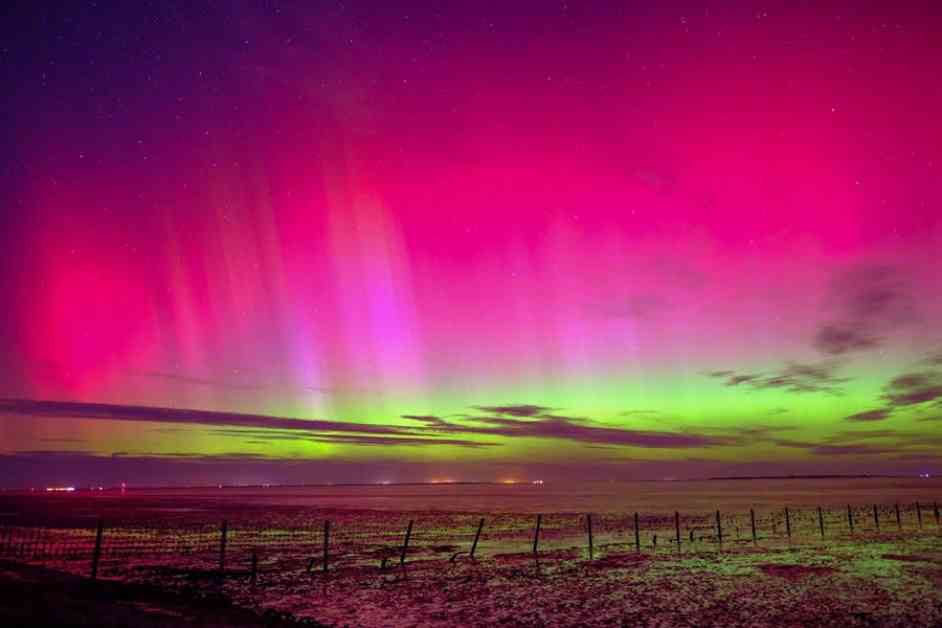Northern Lights Alert: Solar Activity Reaches 23-Year High
The mesmerizing phenomenon of the Aurora Borealis, also known as the Northern Lights, has been captivating observers in Schillig, Lower Saxony. The sky above this region in the Friesland district has been illuminated by the colorful display of lights, creating a breathtaking spectacle. This rare occurrence has sparked excitement among sky watchers and scientists alike as it signifies a significant increase in solar activity.
NOAA’s Space Weather Prediction Center has released a preliminary statement indicating that solar activity has surged to its highest level since March 2001. This surge in activity is attributed to the current solar cycle, which follows an 11-year pattern of waxing and waning magnetic activity on the sun’s surface. A key indicator of this activity is the presence of sunspots, which are magnetic disturbances on the sun’s surface that can be as large as Earth.
Solar Cycle Progression
The current solar cycle, known as Solar Cycle 25, is currently at a 23-year high in terms of solar activity. This cycle has surpassed the activity levels observed during Solar Cycle 24, which spanned from 2009 to 2019. Solar Cycle 25 is now approaching the strength of Solar Cycle 23, which occurred from 1996 to 2008, marking a significant uptick in solar activity over the past two decades.
Astronomers have been meticulously counting sunspots since 1611 to track the sun’s magnetic activity. According to NOAA’s Space Weather Prediction Center, the daily count of sunspots recently reached 337, a number not seen since March 2001. This surge in sunspot activity has been verified by the Solar Influences Data Analysis Center at the Royal Observatory in Belgium, confirming the heightened magnetic activity on the sun.
Solar Maximum Predictions
In a recent announcement, the Solar Influences Data Analysis Center revealed that the monthly average sunspot number for July 2024 reached 196.5, surpassing initial predictions for Solar Cycle 25’s “solar maximum” next summer. The latest forecast from NOAA’s Space Weather Prediction Center suggests that the solar maximum for Solar Cycle 25 may occur between August 2024 and January 2025, indicating a prolonged period of heightened solar activity.
May 2024 witnessed a peak in sunspot activity, with 244.3 sunspots recorded by the SWPC, marking the highest count since December 2001. This surge in sunspot activity coincided with a geomagnetic storm on May 10, 2024, which triggered aurora displays worldwide and was classified as a G5—the most intense level of geomagnetic storm. This level of activity had not been observed since October 31, 2000, underscoring the exceptional nature of the current solar cycle.
Impact of Sunspots
Sunspots play a crucial role in solar activity as they are the source of solar flares, intense bursts of radiation that can travel at the speed of light. Solar flares are often followed by coronal mass ejections, which charge up the solar wind and trigger geomagnetic storms on Earth. These storms can lead to the mesmerizing displays of the Northern Lights, as charged particles interact with Earth’s magnetic field to create ovals of green and red light in the polar regions.
The intensity of geomagnetic storms can influence the visibility of the Northern Lights, pushing the auroral oval further south than usual. While the Northern Lights are typically visible near the Arctic Circle at 65 degrees north, intense geomagnetic storms can extend the visibility to latitudes as low as 40 degrees north or even lower. This phenomenon allows a wider range of observers to witness the beauty of the Aurora Borealis and appreciate the wonders of our solar system.
Unlocking the Mysteries of the Universe
The surge in solar activity and the accompanying displays of the Northern Lights serve as a reminder of the dynamic nature of our sun and its influence on Earth’s magnetic environment. Scientists and astronomers continue to study these phenomena to gain a deeper understanding of solar cycles, sunspots, and geomagnetic storms, unlocking the mysteries of our universe one observation at a time.
As we marvel at the beauty of the Northern Lights and the cosmic dance of charged particles in our atmosphere, we are reminded of the interconnectedness of our planet with the vast expanse of space. The celestial wonders that grace our skies serve as a source of inspiration and awe, prompting us to explore the depths of the cosmos and unravel the secrets of the universe.
Subheadings:
1. Solar Activity Surges to 23-Year High
2. Impact of Sunspots on Geomagnetic Activity
3. Unveiling the Mysteries of the Solar System


